India’s Renewable Energy Revolution
Air Date: Week of June 2, 2017
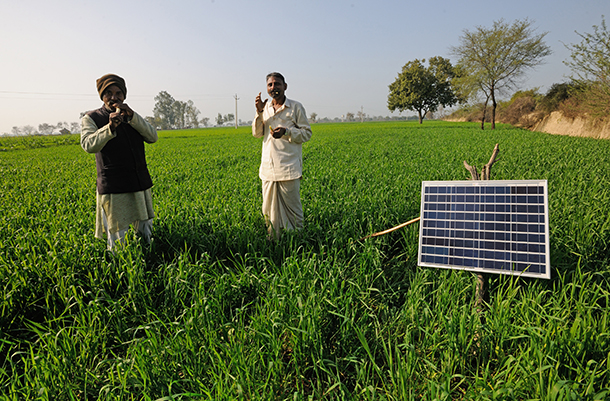
Gopal Singh and Kishen Lal install a solar panel in Mathura, a city in northern India, in 2014. The sprawling nature of the country makes massive centralized power projects costlier and less efficient than smaller, localized power sources. (Photo: Asian Development Bank, Flickr CC BY-NC-ND 2.0)
Prior to the signing of the Paris Climate Agreement, few nations saw India as a leader in climate policy. But in 2015, the world’s third-biggest CO2 emitter began a breathtaking transformation, embracing renewable energy and slashing growth in carbon emissions. Now, the country of 1.3 billion people is a leader of clean energy in the developing world. International environmental reporter Stephen Leahy joins host Steve Curwood to trace India’s remarkable journey to green energy.
Transcript
CURWOOD: It’s Living on Earth, I’m Steve Curwood. For years, India has been reluctant to address limits on global warming gas emissions, citing the need to advance development with coal. But in 2015, when India came to the climate talks in Paris, Prime Minister Narendra Modi spearheaded the launch of an international solar alliance to raise $1 trillion to light up the developing world, and Living on Earth was there.
[INDIAN MUSIC]
MODI: Today, the world must turn to sun to power our future. As the developing world lifts billions of people into prosperity, our hope for a sustainable planet rests on a bold global initiative. The vast majority of humanity is blessed with generous sunlight round the year. Yet, many are also without any source of power. This is why this alliance is so important. We want to bring solar energy into our lives and homes by making it cheaper, more reliable, and easier to connect to grid.
CURWOOD: The alliance will develop best practices and common regulation, stimulate investment and solar product development, Modi said, and will become the foundation of the new economy.
MODI: This is an alliance that brings together developed and developing countries, governments and industries, laboratories and institutions, in a common enterprise. This day is the sunrise of new hope, not just for clean energy, but for villages and homes still in darkness, and for more mornings and evenings filled with the clear view of the glory of the sun. Thank you very much.
[APPLAUSE]
CURWOOD: And now some 18 months later, India’s Prime Minister has turned promise into action at home turning his country of 1.3 billion people into perhaps the world’s best example of the revolution in green energy. International environmental reporter Stephen Leahy has been following this remarkable transition in India, writing about it in National Geographic. Welcome to Living on Earth.
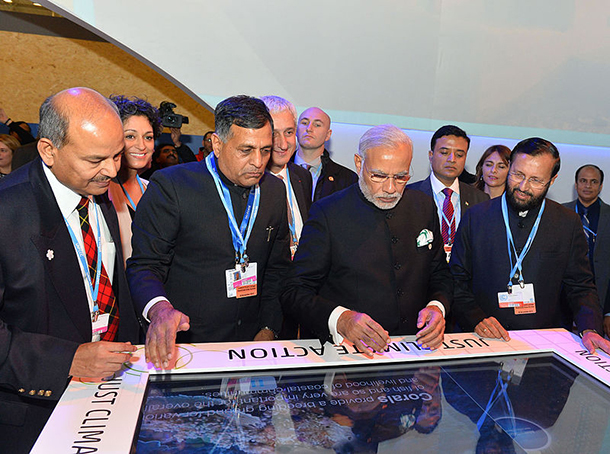
Prime Minister Modi (third from left in the front row) visits the Indian delegation at the 2015 UN Climate Change Conference in Paris. Modi used the talks as a platform to unveil India’s ambitious renewable energy goals. (Photo: Narendra Modi, Wikimedia Commons CC BY-SA 2.0)
LEAHY: Great to be here.
CURWOOD: So, Prime Minister Modi made a big promise at the Paris climate talks to bring solar energy to India and indeed the developing world. To what extent are we seeing that promise actually being carried out here?
LEAHY: Well, I think it's happening faster than anybody expected because it was a gigantic promise. Many people were skeptical that they could deliver, but in just these last two years, they have done remarkable things in terms of creating a new approach to bringing energy to an awful lot of people. A lot of people thought that even if they did try and do it, they couldn't do it this quickly. The perception about India may be that it's a bureaucratic government that takes a long time to make decisions, that there's lots of red tape, but that seems not to be the case when it comes to this.
CURWOOD: You have been covering this for a long time, Stephen. How does this story feel? How exciting is this?
LEAHY: Yeah, I've probably been more excited about this that I have about anything in the last few years since Paris really. Paris was a big development, but that was talk. Now, India is delivering on the ground.
CURWOOD: For the record, how vulnerable is India to climate change?
LEAHY: Yeah, they're one of the most vulnerable countries. They've got water problems, water shortages. They've had huge heat waves that killed hundreds of people. They've got the sea level rise issue with most of the coastal areas. There's threats to their monsoon, which their agriculture is completely dependent upon. So, there's a whole range of real impacts already happening to India right now, and it's only going to get worse in the future.
CURWOOD: Now, as I understand it, there are more than a billion people in India and some 300 million who have no access to electric power. What are the biggest challenges to providing universal electricity access in India?
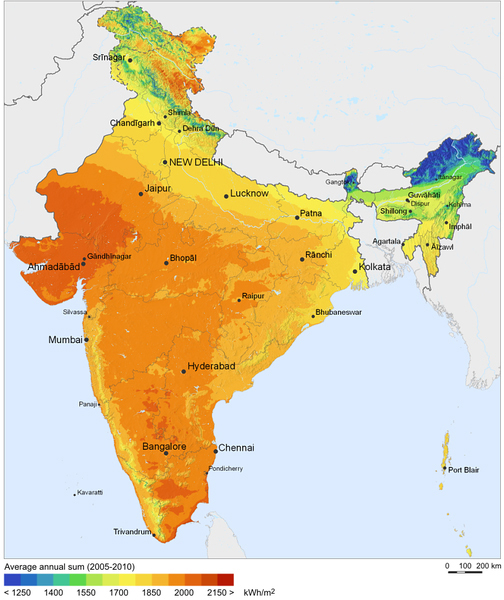
Most of India receives relatively high levels of sunlight, and has tremendous potential for solar power development. (Photo: SolarGIS GeoMode, Wikimedia Commons CC BY-SA 3.0)
LEAHY: One of the biggest problems is the cost. There are lots of small villages spread out over a very large country, and these are poor people who can't afford to pay very much for electricity. So, the beauty of renewable energy is it's cheaper and it's decentralized as much here to install a small solar panel set up or a couple of wind turbines to provide energy in really remote areas.
CURWOOD: So, what are the best benefits of adapting to renewable energy in India?
LEAHY: Well, I think it's the lower-cost. It's the lack of pollution. Right now India is mostly powered by coal, and they have had huge air pollution issues throughout the country. The other aspect that doesn't get as much recognition is the water usage. So all forms of electricity, with the exception of solar and wind, require a lot of good-quality water to generate electricity, and coal uses billions of gallons of water to heat and provide electricity, so we've got this country that has a lot of water shortages, not enough water to grow its crops. The farmers are forced to dig deeper and deeper into aquifers to pump water, to grow some food. Meanwhile, you have coal, of course, which requires lots of water.
CURWOOD: As you wrote, it's now cheaper to produce wind and solar energy in India than it is to produce coal energy. So, how has the country become so successful at lowering the cost of renewable energy?
LEAHY: Well, they have a massive market. That's one of the things that has really driven down the costs of renewable energy, I think not just in India but also round the world where the prices have been falling year on year. But what they're getting right now is a lot of financing from banks in financial institutions who see there's money to be made here. This isn't a charity project. This is a moneymaking venture for a lot of companies, so those folks who are installing renewables and the wind, these are power companies who are borrowing money, millions of dollars from banks and they are planning on making some profits off of this.
CURWOOD: A number of years ago, folks in India were saying they would have to build a lot of coal-fired power plants to light all those homes that don't have electricity. Now they've switched over to renewables and link up to the fact that LEDs require a lot less electricity. How was India able to have that kind of integrated systems thinking, to move forward in this way?
LEAHY: Well, I think they've had strong leadership from Prime Minister Modi that this is the future for India. They've also seen other benefits to renewable energy, for instance, right now India loses about 30 percent of all the energy it generates in transmission losses, but by having decentralized solar power and wind, they've really cut those transmission line losses, and that's a big savings in terms of energy. So, there’s multiple effects of savings of simply a lot of money that no longer needs to go into something as big and massive like a coal plant. Plus they could build renewal energy a lot faster than coal plants.
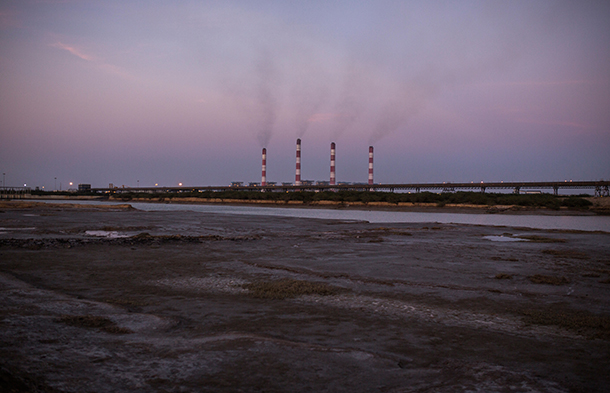
The Mundra Thermal Power Station in the Indian state of Gunjarat is the eleventh largest coal-based thermal power plant in the world. India’s climate goals include weaning itself off of fossil fuels, but as of now, the country is still primarily coal-powered. (Photo: Ariane Wilkinson, Flickr CC BY 2.0)
CURWOOD: Now, someone perhaps in the US or another advanced country will be saying, well, it's alright for India to have a solar and wind, but their intermittent sun doesn't always shine, the wind doesn't always blow. Some electricity is better than none, but really it wouldn't work here because we need electricity 24/7. What's the response?
LEAHY: Well, I did ask the question to the Energy Minister Piyush Goyal, and his answer was, yes, we're going to have coal, we're going to coal to supplement when the wind doesn't blow and the sun isn't shining. We're going to need a combination of energy sources for India's future. But, at the moment, they've said that they're not going to build any new coal plants for probably the next decade. The few that are currently under construction they will complete. After that period of time they are hopeful that they can slowly develop battery storage -- ways of storing renewable intermittent energy -- that technology has been a bit expensive at this point but it's coming along very quickly as well in terms of lower-cost. So, in the future they'll be able to store renewable energy and that will mean they can wean themselves off coal.
CURWOOD: So, how many gigawatts of renewable is India planning to install in this program?
LEAHY: They plan to add 160 gigawatts over the next four years and they may be able to do that even sooner. For comparison, the US into 2015 had just over 100 gigawatts in solar and wind and of course that took several decades to build up to that 100 gigawatts.
CURWOOD: So, if the US doesn't get a move on, India is going to pass the United States, huh?
LEAHY: Yes, they will probably pass the US by the year, 2000, 2022.
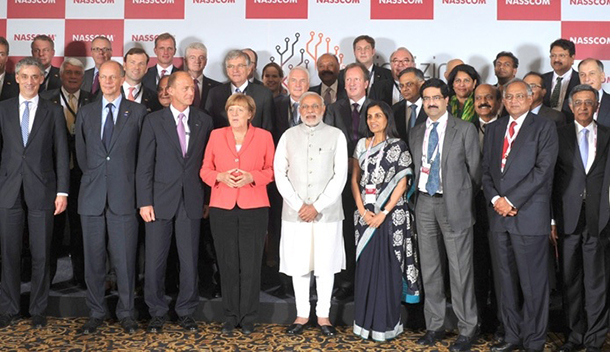
Prime Minister Modi attends a business forum in Bangalore with German Chancellor Angela Merkel in 2015. On Tuesday, Modi reiterated his commitment to partner with German leadership on global green energy policy. (Photo: Narendra Modi, Wikimedia Commons CC BY-SA 2.0)
CURWOOD: Stephen, it seems to me that in a funny kind of way, India has an advantage with so many people without any electricity that they're leap frogging all that the costly infrastructure that we have -- your perception?
LEAHY: Well, they have a driving need to get electricity to people who don't have it and this is true in a lot of developing countries. They want change, they need change, they know they have to make change, so they're willing to put the resources and the urgency into having these things like renewable happen quickly, whereas, industrialized countries are already fairly comfortable, and we don't necessarily see a pressing urgency for change. So, I think that's part of the motivation. Secondarily, they don't need a lot of electricity. They just need a little bit of electricity for lighting to charge their phones. It's not necessary to provide the amount of electricity that the average American enjoys currently.
CURWOOD: What kind of transformation for a villager who had no electricity before does solar and/or wind bring to his village?
LEAHY: It could be huge because now at night instead of having a smokey lantern powered by using kerosene, which has its own hazards. It's a fire hazard. So, now with an LED light, a young student can do his homework in the evenings whereas it would have been too dark or the flickering light would've been also too expensive. LEDs are cheaper than kerosene. So, there's a number of things. They can also look at, well, there are now low-power LED kind of like, flash drive computers that used very little energy, so small little lap tops could be something that can be powered by -- easily powered by solar or wind. So, these are all new things that will be able to be part of the average village in India.
CURWOOD: I imagine with all those things, it'll be a huge leap the middle class for those people.
LEAHY: Yeah, and I think it will also be able to provide lots of services. If you have access to the internet, and you're a farmer, well then you can get a better price for your crops because you'll know what the average selling price is for other regions. So, there's a whole pile of advantages electricity will bring. I mean, let's face it. Who doesn't want to have electricity?
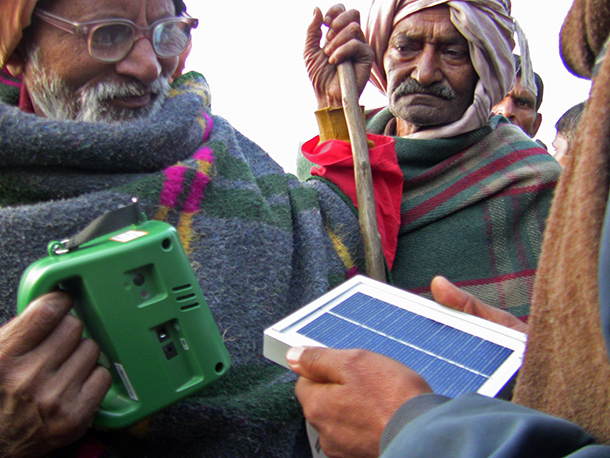
At a marketplace in Mankapur, India, locals inspect an LED lantern as a replacement for kerosene lights. The country has already successfully replaced 235 million household and street lights with LED technology. (Photo: Engineering for Change, Flickr CC BY-SA 2.0)
CURWOOD: So, the top emitters in the world, Stephen, as you know, China and the US and then India. Each country made pledges at Paris. India's plan ... how does this put it on the path to meet its promises at Paris, do you think?
LEAHY: Yeah, India going to meet its Paris commitments. It's going to, according to the latest analysis by scientists, if it is able to pull this off, which is what it's already in the middle of doing -- It will exceed those commitments and for comparison the US is not on track to make its Paris commitments, nor for that matter neither is Canada, unfortunately.
CURWOOD: We should note that you're Canadian.
LEAHY: Yes.
CURWOOD: So Prime Minister Modi has a term that ends, I believe, in 2019. How critical is he in this green energy transformation and how lasting might these policies be if someone else were to take office there?
LEAHY: Well that's an important question. I think Prime Minister Modi has been essential to this transition, and I think by 2019 -- because so many things will have been delivered -- the LED lights, the access to energy for everyone in India, massive amounts of new, renewable energy -- I think it will be too far down the road for India to turn back completely. It's certainly impossible that a new government might reemphasize coal, but I think the general public will have seen the benefits, they will have seen it's real, and they will I think understand that this is where India has to go for its future.
CURWOOD: What can other developing countries learn from India's energy transformation, do you think?
LEAHY: I think they've learned it can happen very quickly, that it's lower cost, and it can provide, like, you know, benefits to people who have not had access to electricity in a very short period of time, one or two years as opposed to a five or 10 year and hyper-expensive megaproject. And it brings real benefits to local people without having some of the downsides of massive infrastructure projects, which can be very disruptive. They won’t have the air pollution issues. They will also be protecting their water resources.
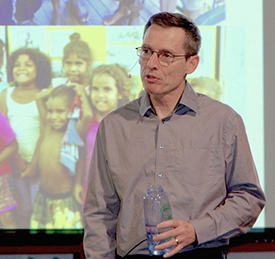
Stephen Leahy is an international environmental journalist. His recent coverage of India’s green energy transformation appeared in National Geographic. (Photo: Stephen Leahy)
CURWOOD: And what about the United States? What can or should the US learn from India's progress on this energy transformation?
LEAHY: Well, I think they should understand that coal is not the answer, going back to coal and that fossil fuels … the day of fuel fuels is over. And that even a country that is a developing country with all sorts of social and other issues can make this rapid transition to renewable energy for the benefit of its citizens, but also for the benefits of this economy. They're building what we call a 21st century economy around renewable.
CURWOOD: Stephen Leahy is an independent journalist covering environmental issues. His most recent reporting on India's renewable energy transformation appeared in National Geographic. Stephen, thanks so much for taking the time with us today.
LEAHY: You're very welcome.
Links
National Geographic: “India Launches Massive Push for Clean Power, Lighting, and Cars”
Washington Post: “As Merkel seeks allies elsewhere, Modi visits Berlin bursting with friendliness”
Living on Earth’s coverage of India’s solar commitments at COP21
Living on Earth wants to hear from you!
Living on Earth
62 Calef Highway, Suite 212
Lee, NH 03861
Telephone: 617-287-4121
E-mail: comments@loe.org
Newsletter [Click here]
Donate to Living on Earth!
Living on Earth is an independent media program and relies entirely on contributions from listeners and institutions supporting public service. Please donate now to preserve an independent environmental voice.
NewsletterLiving on Earth offers a weekly delivery of the show's rundown to your mailbox. Sign up for our newsletter today!
 Sailors For The Sea: Be the change you want to sea.
Sailors For The Sea: Be the change you want to sea.
 The Grantham Foundation for the Protection of the Environment: Committed to protecting and improving the health of the global environment.
The Grantham Foundation for the Protection of the Environment: Committed to protecting and improving the health of the global environment.
 Contribute to Living on Earth and receive, as our gift to you, an archival print of one of Mark Seth Lender's extraordinary wildlife photographs. Follow the link to see Mark's current collection of photographs.
Contribute to Living on Earth and receive, as our gift to you, an archival print of one of Mark Seth Lender's extraordinary wildlife photographs. Follow the link to see Mark's current collection of photographs.
 Buy a signed copy of Mark Seth Lender's book Smeagull the Seagull & support Living on Earth
Buy a signed copy of Mark Seth Lender's book Smeagull the Seagull & support Living on Earth

